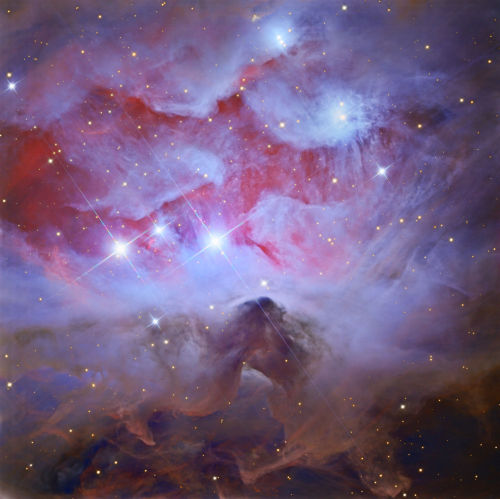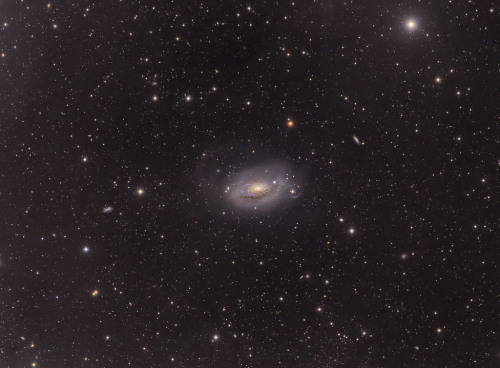A ‘matryoshka’ In The Interstellar Medium

A ‘matryoshka’ in the interstellar medium
As if it were one of the known Russian dolls, a group of astronomers, led by researchers at the Instituto de Astrofísica de Canarias, (IAC) has found the first known case of three supernova remnants one inside the other. Using the programme BUBBLY, a method developed within the group for detecting huge expanding bubbles of gas in interstellar space, they were observing the galaxy M33 in our Local Group of galaxies and found example of a triple-bubble. The results, which were published yesterday in the journal Monthly Notices of the Royal Astronomical Society, help to understand the feedback phenomenon, a fundamental process of star formation and in the dissemination of metals produced in massive stars.
The group has been building up a data base of these superbubbles with observations of a number of galaxies and, using the very high resolution 2D spectrograph, GHaFaS (Galaxy Halpha Fabry-Perot System), on the 4.2 m William Herschel Telescope (WHT) of the Isaac Newton Group of Telescopes (Roque de los Muchachos Observatory, La Palma), has been able to detect and measure these superbubbles, which range in size from a few light years to as big as a thousand light years across.
Superbubbles around large young star clusters are known to have a complex structure due to the effects of powerful stellar winds and supernova explosions of individual stars, whose separate bubbles may end up merging into a superbubble, but this is the first time that they, or any other observers, have found three concentric expanding supernova shells.
“This phenomenon -says John Beckman, one of the co-authors on the paper- allows to explore the interstellar medium in a unique way, we can measure how much matter there is in a shell, approximately a couple of hundred times the mass of the sun in each of the shells”. However, if it is known that a supernova expels only around ten times the mass of the sun, where do the second and third shells get their gas from if the first supernova sweeps up all the gas?
The answer to that must come from the surrounding gas and in the inhomogeneous interstellar medium. “It must be -says Artemi Camps Fariña, who is first author on the paper-, that the interstellar medium is not at all uniform, there must be dense clumps of gas, surrounded by space with gas at a much lower density. A supernova does not just sweep up gas, it evaporates the outsides of the clumps, leaving some dense gas behind which can make the second and the third shells”.
“The presence of the bubbles -adds Artemi- explains why star formation has been much slower than simple models of galaxy evolution predicted. These bubbles are part of a widespread feedback process in galaxy disc and if it were not for feedback, spiral galaxies would have very short lives, and our own existence would be improbable”, concludes. The idea of an inhomogeneous interstellar medium is not new, but the triple bubble gives a much clearer and quantitative view of the structure and the feedback process. The results will help theorists working on feedback to a better understanding of how this process works in all galaxy discs.
More Posts from Littlecadet-biguniverse and Others

Bubble Nebula by Hubble Heritage Via Flickr: For the 26th birthday of NASA’s Hubble Space Telescope, astronomers are highlighting a Hubble image of an enormous bubble being blown into space by a super-hot, massive star. The Hubble image of the Bubble Nebula, or NGC 7635, was chosen to mark the 26th anniversary of the launch of Hubble into Earth orbit by the STS-31 space shuttle crew on April 24, 1990. The Bubble Nebula is 7 light-years across — about one-and-a-half times the distance from our sun to its nearest stellar neighbor, Alpha Centauri. The Bubble Nebula was discovered in 1787 by William Herschel, a prominent British astronomer. It is being formed by a prototypical Wolf-Rayet star, an extremely bright, massive, and short-lived star that has lost most of its outer hydrogen and is now fusing helium into heavier elements. The star is about 4 million years old, and in 10 million to 20 million years, it will likely detonate as a supernova.
Credit: NASA, ESA, and the Hubble Heritage Team (STScI/AURA) heritage.stsci.edu/2016/13/ hubbledev.stsci.edu/newscenter/archive/releases/2016/13/

Island Point Milky Way
Nikon d5100 - 6 x 25s - ISO 4000 - f2.8 - 16mm

Running Man Nebula
js

Three LEGO Minifigures Journey to Jupiter
Did you know that the Juno mission is also one giant leap for minifigure-kind? Three LEGO crew members have set their sights on being the first toy to visit another planet, enduring the five year, 1.75 billion mile journey aboard NASA’s Juno spacecraft. One minifigure is a likeness of Galileo Galilei – who discovered Jupiter’s four largest moons. The other two represent the Roman god Jupiter and his wife Juno. Each figure has been custom molded out of aluminum to represent their special characteristics. Jupiter carries a lightning bolt, Juno has a magnifying glass to represent her search for truth, Galileo is carrying a telescope and a model of the planet Jupiter.
To me, these minifigures add a beautifully ordinary and intensely human element to this extraordinary mission.
Explore more of the LEGO Group’s partnership with NASA at LEGO.com/Space

The California Nebula.

What forms lurk in the mists of the Carina Nebula? The dark ominous figures are actually molecular clouds, knots of molecular gas and dust so thick they have become opaque. In comparison, however, these clouds are typically much less dense than Earth’s atmosphere. Featured here is a detailed image of the core of the Carina Nebula, a part where both dark and colorful clouds of gas and dust are particularly prominent. The image was captured last month from Siding Spring Observatory in Australia. Although the nebula is predominantly composed of hydrogen gas – here colored green, the image was assigned colors so that light emitted by trace amounts of sulfur and oxygen appear red and blue, respectively. The entire Carina Nebula, cataloged as NGC 3372, spans over 300 light years and lies about 7,500 light-years away in the constellation of Carina. Eta Carinae, the most energetic star in the nebula, was one of the brightest stars in the sky in the 1830s, but then faded dramatically.
Object Names: Carina Nebula
Image Type: Astronomical
Credit: John Ebersole
Time And Space


Top: Hubble’s infrared vision pierced the dusty heart of our Milky Way galaxy to reveal more than half a million stars at its core. At the very hub of our galaxy, this star cluster surrounds the Milky Way’s central supermassive black hole, which is about 4 million times the mass of our sun.
Credits: NASA, ESA, and Hubble Heritage Team (STScI/AURA, Acknowledgment: T. Do, A.Ghez (UCLA), V. Bajaj (STScI)
Bottom: This annotated, infrared image from the Hubble Space Telescope shows the scale of the galactic core. The galaxy’s nucleus (marked) is home to a central, supermassive black hole called Sagittarius A-star.
Credits: NASA, ESA, and the Hubble Heritage Team (STScI/AURA) Acknowledgment: T. Do, A.Ghez (UCLA),V. Bajaj (STScI)

M63 // Sunflower Galaxy
-
 gloryofboot liked this · 1 year ago
gloryofboot liked this · 1 year ago -
 trifoliate-undergrowth liked this · 1 year ago
trifoliate-undergrowth liked this · 1 year ago -
 mossnmoss reblogged this · 1 year ago
mossnmoss reblogged this · 1 year ago -
 mossnmoss liked this · 1 year ago
mossnmoss liked this · 1 year ago -
 sunlaire reblogged this · 1 year ago
sunlaire reblogged this · 1 year ago -
 selenesparis liked this · 3 years ago
selenesparis liked this · 3 years ago -
 punkrock-furiosa liked this · 3 years ago
punkrock-furiosa liked this · 3 years ago -
 bluecat1487 reblogged this · 4 years ago
bluecat1487 reblogged this · 4 years ago -
 vessel-of-horror reblogged this · 4 years ago
vessel-of-horror reblogged this · 4 years ago -
 curiumm reblogged this · 4 years ago
curiumm reblogged this · 4 years ago -
 curiumm liked this · 4 years ago
curiumm liked this · 4 years ago -
 ambrysia liked this · 4 years ago
ambrysia liked this · 4 years ago -
 thot-in-this-economy-blog liked this · 5 years ago
thot-in-this-economy-blog liked this · 5 years ago -
 casssin1-astroboy liked this · 5 years ago
casssin1-astroboy liked this · 5 years ago -
 darkvira liked this · 5 years ago
darkvira liked this · 5 years ago -
 breninarthur liked this · 6 years ago
breninarthur liked this · 6 years ago -
 em0v4mpire liked this · 6 years ago
em0v4mpire liked this · 6 years ago -
 d--r--i--f--t--w--o--o--d reblogged this · 6 years ago
d--r--i--f--t--w--o--o--d reblogged this · 6 years ago -
 indelikatt reblogged this · 6 years ago
indelikatt reblogged this · 6 years ago -
 bodyinthebog reblogged this · 6 years ago
bodyinthebog reblogged this · 6 years ago -
 soberchicagogay liked this · 6 years ago
soberchicagogay liked this · 6 years ago -
 oobyssirp liked this · 6 years ago
oobyssirp liked this · 6 years ago -
 raangmanch liked this · 6 years ago
raangmanch liked this · 6 years ago -
 thalionore09 liked this · 6 years ago
thalionore09 liked this · 6 years ago -
 megillien liked this · 6 years ago
megillien liked this · 6 years ago -
 insomniarama reblogged this · 6 years ago
insomniarama reblogged this · 6 years ago -
 indelikatt liked this · 6 years ago
indelikatt liked this · 6 years ago -
 youidiotkid liked this · 6 years ago
youidiotkid liked this · 6 years ago -
 alexissrose reblogged this · 6 years ago
alexissrose reblogged this · 6 years ago -
 spaceblogger32-blog liked this · 6 years ago
spaceblogger32-blog liked this · 6 years ago -
 leaveyourburdens-blog liked this · 6 years ago
leaveyourburdens-blog liked this · 6 years ago -
 lenthebabe reblogged this · 7 years ago
lenthebabe reblogged this · 7 years ago -
 lenthebabe reblogged this · 7 years ago
lenthebabe reblogged this · 7 years ago
GREETINGS FROM EARTH! Welcome to my space blog! Let's explore the stars together!!!
144 posts
